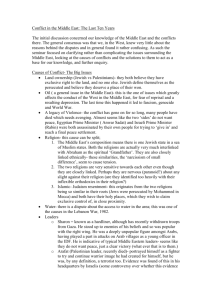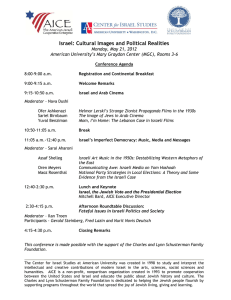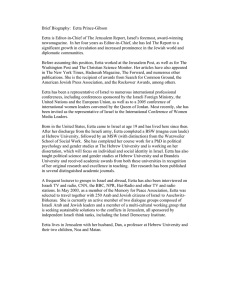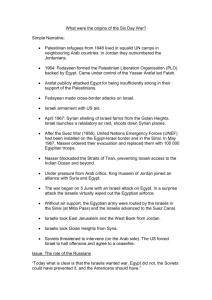The 1967 ‘Six Day’ Arab-Israeli War Matthew Hughes
advertisement
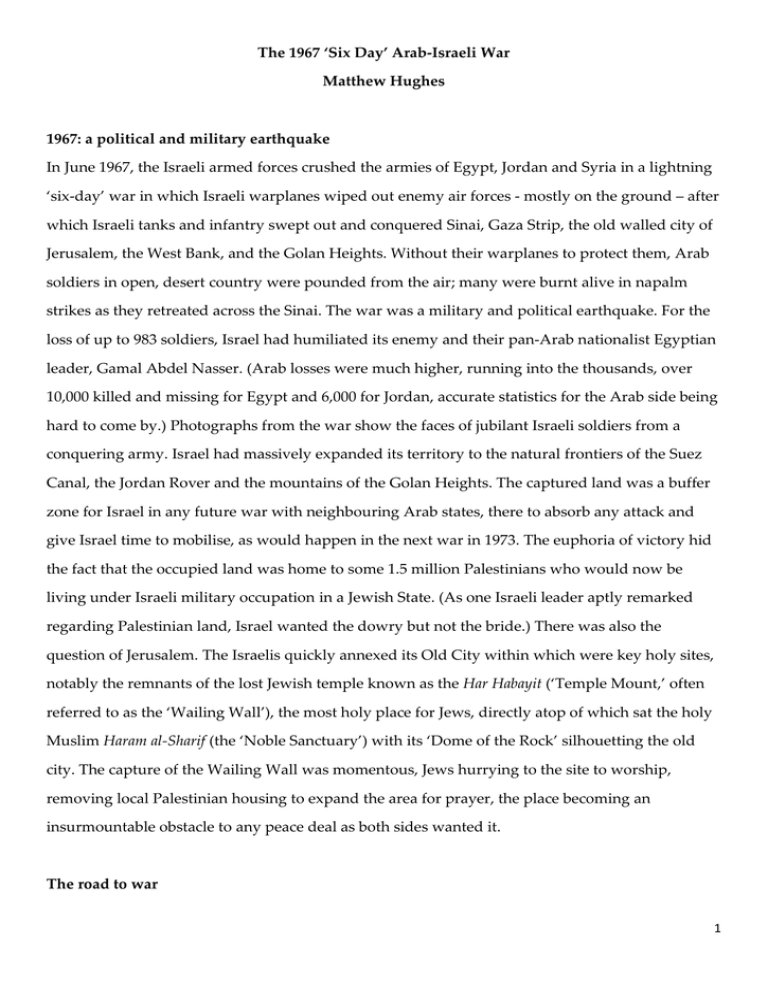
The 1967 ‘Six Day’ Arab-Israeli War Matthew Hughes 1967: a political and military earthquake In June 1967, the Israeli armed forces crushed the armies of Egypt, Jordan and Syria in a lightning ‘six-day’ war in which Israeli warplanes wiped out enemy air forces - mostly on the ground – after which Israeli tanks and infantry swept out and conquered Sinai, Gaza Strip, the old walled city of Jerusalem, the West Bank, and the Golan Heights. Without their warplanes to protect them, Arab soldiers in open, desert country were pounded from the air; many were burnt alive in napalm strikes as they retreated across the Sinai. The war was a military and political earthquake. For the loss of up to 983 soldiers, Israel had humiliated its enemy and their pan-Arab nationalist Egyptian leader, Gamal Abdel Nasser. (Arab losses were much higher, running into the thousands, over 10,000 killed and missing for Egypt and 6,000 for Jordan, accurate statistics for the Arab side being hard to come by.) Photographs from the war show the faces of jubilant Israeli soldiers from a conquering army. Israel had massively expanded its territory to the natural frontiers of the Suez Canal, the Jordan Rover and the mountains of the Golan Heights. The captured land was a buffer zone for Israel in any future war with neighbouring Arab states, there to absorb any attack and give Israel time to mobilise, as would happen in the next war in 1973. The euphoria of victory hid the fact that the occupied land was home to some 1.5 million Palestinians who would now be living under Israeli military occupation in a Jewish State. (As one Israeli leader aptly remarked regarding Palestinian land, Israel wanted the dowry but not the bride.) There was also the question of Jerusalem. The Israelis quickly annexed its Old City within which were key holy sites, notably the remnants of the lost Jewish temple known as the Har Habayit (‘Temple Mount,’ often referred to as the ‘Wailing Wall’), the most holy place for Jews, directly atop of which sat the holy Muslim Haram al-Sharif (the ‘Noble Sanctuary’) with its ‘Dome of the Rock’ silhouetting the old city. The capture of the Wailing Wall was momentous, Jews hurrying to the site to worship, removing local Palestinian housing to expand the area for prayer, the place becoming an insurmountable obstacle to any peace deal as both sides wanted it. The road to war 1 The 1967 war was the third clash in a set of Arab-Israeli wars that have continued to the present day. There had been two previous wars in 1948-49 and 1956 (after which the United Nations stationed peacekeeping troops in the Sinai) and there would be further ones in 1969-70, 1973, 1982, and 2006. Of these wars, the one in 1967 was the one that neither side wanted. Instead, they fell into the abyss of war. How did this happen? Two key drivers for the 1967 war – security and legitimacy – worked alongside poor, confused diplomacy in the months immediately before June 1967 to cause the war. For Israel, its security as a small country with no strategic depth, recently formed in May 1948, confronted by a united anti-Israeli Arab bloc armed by the Soviet Union and led by a charismatic figure, Nasser, bent on destroying the Jewish State, was paramount. Israel felt that it had to defend itself in the face of an external, existential, anti-Semitic threat from what it considered to be monolithic Arab opposition and so launched a pre-emptive strike in June 1967 when encircled and faced with a multi-front war. This was how Israelis perceived the war in 1967, a view supported by years of border clashes when enemy soldiers and Palestinian guerrillas struck into Israel. Behind Arab military power, there was the menace of pan-Arabism and anti-Israeli rhetoric from bombastic leaders such as Nasser. For the other side, Israel was an aggressive, illegitimate State, founded on the expulsion of Palestinians in 1948 and never recognised by the Arab states. After the 1948-49 war, there were armistices between the two sides but no peace treaties. Indeed, Israel had no formal diplomatic relations with any Arab State until 1979 when Egypt signed the first peace with Israel. Instead of an external Arab threat causing war, aggressive internal Israeli politics from a militarized, colonial Jewish State – what has been called the Israeli ‘iron wall’ – meant that Israel was looking for trouble, escalating endemic border clashes to provoke its Arab neighbours, forcing them into a war, at which point superior Israeli military might would go into action. Israeli military power would keep the country safe and was preferred over diplomacy. Expanded territory provided security and space for more Jewish settlement of Palestinian lands. 2 An eliminationist threat to Israel versus an aggressive, trigger-finger Israel give over-arching answers to the question of why Israel and the neighbouring Arab states have fought so many war. But what of the actual history of the 1967 war? The events leading up to the June 1967 war provide the satisfying detailed historical explanation as to why war happened and allow us to test these two contending pro- and anti-Israeli viewpoints. War was not inevitable in June 1967. A crisis slide from early 1967 transformed already poor relations between the two sides and tensions along the border into a shooting war. The countdown to war started on the Golan front with Syria. On 7 April 1967, after cross-border shelling, Israeli warplanes shot down six Syrian Soviet-supplied MiG fighters – two of them close to Damascus – and Israelis were certain that the Syrians were responsible for the initial shelling. Many years later, the senior Israeli general, Moshe Dayan, claimed that Israel started 80% of the border clashes – its ‘Syrian Syndrome.’ Elements within the Israeli high command, it seems, did not accept the 1949 border with Syria and so they goaded the Syrians with provocations along an already unsettled border. What is certain is that these local skirmishes led to a full-blown war. The Soviets strongly supported the Syrian regime and they had to counter any threat to their ally in Damascus. The Soviets sent a fake report to Nasser in Egypt – the strongest Arab power – saying that the Israelis were massing for a land attack on Syria. They were not; this was a lie designed to get Nasser to do something to support the Syrians. Nasser was in a quandary as he could not afford to do nothing against Israel but the best units in his army were away fighting another war in Yemen and so he was unprepared for a clash with Israel. He knew that Israel was stronger militarily. Nevertheless, Nasser then made fateful decisions designed to show the wider Arab world that he was in charge: he moved troops into the Sinai; he asked the United Nations force that had been in the Sinai as a peace buffer force since 1957 to leave; and he closed the Straits of Tiran to Israeli shipping, blockading the Israeli port of Eilat. Israel had long said that closing passage through Tiran would be a casus belli, a cause for war. Nasser’s gamble to appear strong failed, terribly. The Israelis relied on the deterrence factor of their armed forces and for two weeks Israelis waited in fear – memories of the Holocaust fresh in many people’s minds – while their Prime Minister, Levi Eshkol, dithered. Military pressure on Eshkol intensified, with Israeli 3 commanders keen to take the initiative with decisive action against Egypt before it was too late. Israel’s foreign intelligence service, Mossad, reported that America would welcome a strike against Nasser – another Soviet ally – and on 4 June, the Israeli cabinet agreed on war. Mutual distrust, dismal diplomacy by Nasser, Soviet deceit, fears inside of Israel at possible destruction, and the pressure of ‘hawks’ within the Israeli Government combined to make war inevitable on 5 June 1967. Blitzkrieg, 5-10 June 1967 At 7.45 am on 5 June, almost 200 Israeli warplanes (many supplied by France) launched the assault with a devastating aerial sweep in from the sea and the west onto Egypt, catching Egyptian pilots on the ground having their breakfast. This was Israel’s ‘Operation Moked.’ The Egyptians were utterly unprepared, their radar turned off – also, the Israeli were coming in from an unexpected direction, not the east as expected – and by the end of the day, the Egyptian air force had lost 300 warplanes. The lack of protective air cover exposed the Egyptian troops facing the enemy in the Sinai to subsequent Israeli air and tank assaults, and units fell apart as men fled back to the Suez Canal pursued by the Israelis. The Israeli army pushed all the way to the wide defensive width of the canal. The Israelis also occupied the Gaza Strip, home to some 300,000 Palestinians, many refugees from the 1948 war. The war then spread and later in the morning of 5 June, Jordanian guns opened up against Israel, at which point Israel specifically told the Jordanian leader, King Hussein, that its fight was with Egypt and not Jordan. Hussein then pulled himself into the war, spurred on by mischievous reports from Egypt that it was defeating Israel (Egypt amazingly told Jordan that it had destroyed three-quarters of the Israeli air force), by fears of missing the boat if the Arab side was victorious, and mindful of Palestinians living on the West Bank who wanted to see Israel defeated. Israel then turned on Jordan and in a series of aerial sorties destroyed its smaller air force. At the same time, Israeli troops surrounded and sealed off Jerusalem’s Old City from the east. The Jordanians fought hard outside the city walls but without air cover, they were cut-off and by 7 June Israeli paratroopers operating as infantry attacked into the Old City, from the rear through St Stephen’s Gate and pushed through its narrow alleys to the prize of the Temple Mount and Wailing Wall, 4 whose capture restored to the Jews the temple destroyed by the Romans. Israeli commanders quickly removed a casualty evacuation station set up in the Muslim holy area atop the Wailing Wall, mindful of the religious sensitivities of the site. Israel’s simultaneous capture of the West Bank – biblical Judaea and Samaria – was also of great religious significance to the Jewish State. Meanwhile, on the northern Syrian front, where all the trouble leading to the war had started, Syria witnessed the defeat of Egypt and Jordan and so sought to stay out of the war, refusing a plea for help from Hussein’s Jordanian army for Syrian warplanes. Nevertheless, the senior Israeli Minister of Defence and soldier, Moshe Dayan, decided to hit Syria while he could and take the strategic volcanic Golan plateau, and on 9 June Israel attacked a final time. With Egypt and Jordan defeated, the Israelis focused all their firepower on the Syrian brigades on the Golan Heights. The Soviets threatened action to support their Syrian ally but in the end did nothing to stop the Israelis. Syrian troops resisted from strongpoints on the higher slopes – some of these have been left as a memorial by the Israelis and the trenches and bunkers can be visited today – but Israeli infantry attacking from the rear overwhelmed them, Syrian soldiers breaking and retreating by 10 June leaving behind masses of military equipment. At the war’s end, crack Israeli heliborne Golani Brigade troops landed on and took parts of Mount Hermon (2814 metres, in Arabic, Jabal alShaykh) in the north that commanded the Golan area and looked down on Damascus. The Israelis then fixed a new frontline on a series of volcanic hills (called tells) from Hermon in the north down the Golan Heights that afforded natural defensive positions. In a decisive campaign, Israel had seized huge areas of land, expanding its territory fourfold from 20,250 square kilometres on 5 June to 88,000 square kilometres by the end of the war on the 10th. Israeli soldiers were now just 50 kilometres from Jordan’s capital, Amman, 60 kilometres from Damascus, and perched on the Suez Canal only 110 kilometres from Cairo. Nasser had talked himself into a war that destroyed not just his army and prestige but also those of the other frontline Arab states. War had provided a military solution to the political problems of the legitimacy of Israel and the right of the Palestinians to their own nation state. Israel was triumphant; any threat was seemingly neutralized with Israeli forces now poised close to Arab capital cities; Nasser 5 and his allies were humiliated. While the war was firmly defensive for the Israelis, it was a war of conquest and aggression for their opponents. The USS Liberty incident On 8 June, in the middle of the war, Israeli warplanes and motor torpedo boats attacked an unarmed US spy ship, the USS Liberty, there to monitor the war’s progress, from international waters off the northern Sinai coast, killing 34 US sailors and wounding almost 200 in the attack. This was an act of war against Israel’s ally, the US. The Israelis claimed this at the time as a mistake, a tragic example of the fog of war where they thought that they were attacking an Egyptian spy ship, but recent evidence confirms that the Israelis knew that the ship was American. The Israelis did not want Americans monitoring (and maybe halting) their offensive; the Americans afterwards threatened military action but did nothing, instead accepting Israeli compensation for the sailors killed and injured. A. Jay Cristol tells the story in full in his The Liberty Incident: The 1967 Israeli Attack on the US Navy Spy Ship (2002). Aftermath and legacy The 1967 victory transformed Israel and the Middle East. Initially, the Israeli Government had no coherent plan for the new lands taken and on 19 June made an offer to withdraw with certain conditions. The Arab states rejected this offer – backing up the Israeli quip that their Arab enemy never lost an opportunity to miss an opportunity. In truth, the 19 June offer was premature and over the summer of 1967, the Israeli stance hardened, their Government realising that the offer to withdraw was rash and that they needed to maintain the new borders, certainly on the Suez Canal and Golan heights, in some form. The Israelis were less clear about what to do with the West Bank – minus the Old City of Jerusalem annexed by 27 June as Israeli sovereign territory – there being plans to give it back to Jordan or to effect some sort of Palestinian autonomy under Israeli overall control (both strategies led nowhere). In the absence of a definitive political position at the highest levels in Israel, events on the ground led the way. The capture of vast swathes of territory radicalized Jewish nationalism – Zionism – from a minimalist to a more maximalist position, opening up a more religious, settler-orientated, right6 wing (almost messianic) Zionism, one that would see Israel’s first right-wing Likud Government voted in to power in 1977. New Israeli political movements such as Gush Emunim (‘Bloc of the Faithful’) were formed to settle the lands conquered in 1967, pitting Israeli settlers against the existing Palestinian population. Settlers on the ground drove forward Israeli political decisionmaking, creating facts on the ground. The war polarized both sides with the Israelis refusing a complete withdrawal and the Arab states refusing anything but a total withdrawal to the front line of 5 June 1967. Meanwhile, the Americans stepped up their support for victorious Israel, the Soviets re-armed Egypt and Syria, and the United Nations passed Resolution 242 that demanded Israeli withdrawal but also recognised Israel’s right to exist. On the Arab side, the 1967 war pushed the Palestinians to strengthen their own national forces rather than relying on defeated leaders such as Nasser, groups like the Palestine Liberation Organisation bursting on to the world scene with spectacular terrorist actions such as plane hijackings to highlight their cause. Meanwhile, the Arab states met in Khartoum in late August 1967 to take stock, famously concluding the summit with the three ‘noes’: no recognition, no negotiation and no peace with Israel. In fact, there were moderate forces in Khartoum, including Nasser, who were willing to engage in political dialogue with Israel, not something known to the Israelis at the time. Israel’s victory in 1967 was complete, giving little impetus to the Israelis to talk while leaving the Arab side humiliated, seeking revenge. The ceasefire lines of 10 June 1967 soon became de facto borders and it would take more wars to jolt the two sides back into political dialogue, at which point Israeli annexation of Jerusalem and increasing Jewish settlement of occupied territory made a viable political settlement very difficult. The 1967 war was a military solution to the political problems of Israel’s right to exist alongside Palestinian self-determination. The failure of post-war diplomacy polarised positions, deepened the rifts between the two sides, and made a long-term political solution less likely, instead leading to more wars. Further reading Jeremy Bowen, Six Days: How the 1967 War Shaped the Middle East (2004) 7 Ahron Bregman, Israel’s Wars: A History since 1947 (2010) (third edition) Avi Shlaim, The Iron Wall: Israel and the Arab World (2014) (second edition) Matthew Hughes is Professor of Military History at Brunel University 8
